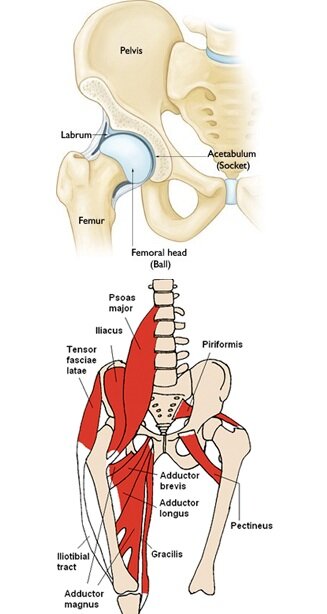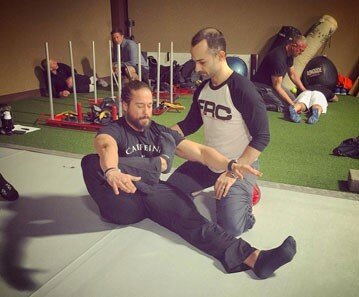Fix Your Hips to Ease Back Pain
Speaking from experience, many of us, particularly those getting older, have experienced hip and lower back pain in our lives. While it’s natural to think that you may be suffering from physical wear-and-tear or a joint injury, the issue can in many cases may be more basic and easier to fix.
You may have heard the idea that sitting is this generation's smoking, meaning that technology, longer work hours, and other factors have exacerbated the hazards of prolonged sitting. One of the several negative health impacts of sitting for extended periods of time is a shortening or tightening of the muscles needed for hip flexion (bringing femur and knee towards your torso). Biomechanics expert Justin Price provides an excellent, detailed description of the musculoskeletal chain of hip-related muscular effects that can lead to lower back and hip pain. The domino effect starts with a shortening of the hip flexors (the five muscles that connect the lower spine and pelvis to the inside of the femur), which precipitates a tilting of the pelvis (anterior pelvic tilt), which then leads to various parts of the lower body accommodating the reduced range of motion allowed by the hip flexors (e.g., arching of the lower back, or lumbar spine, during the backward swing of the leg when running; and over-pronation of the knee/ankle, and misalignment of the hip, when walking/running). So, the very simple message is that extended periods of sitting can lead to tight hips, lower body joint pain, and lower back discomfort.
The key question is how to address the chain of events that leads to back and joint pain. There is a good amount of research available on this topic, though it is fairly dispersed. So, we’ve tried to summarize the key preventative and reactive tools available in back pain relief toolbox:
Stand Up! With a root cause of tight hip flexors being extended periods of sitting, a key preventative remedy is to stand and move regularly to prevent a shortening of the hip muscles. Kinesiology professor Jack Callaghan from the University of Waterloo recommends a sit:stand ratio of between 1:1 and 1:3 in order to address both back and broader health issues associated with excessive sitting.
Massage – To relax taught hip flexors and/or address specific points of muscular tension, Dr. Sue Beckham recommends using balls (medicine or tennis), or foam rollers, to release trigger points or localized muscular contractions that can develop due to muscle shortening caused by extended sitting. You can watch a great demonstration of hip flexor massaging here.
Stretch – After normalizing the length of the hip flexor muscles through massage, there are a number of different stretches that can be used to increase the hip’s range of motion, thereby easing the tension or pull on the lower back:
Kneeling Lunge – This is the most basic and common hip flexor stretch. The stretch is executed by kneeling on one knee (forming a 90 degree knee angle), “lunging” forward with the opposite knee (also creating a 90 degree knee angle), and gently pushing the hips forward to stretch the hip flexors of the kneeling leg. Be sure to focus on contracting the (perhaps) dormant, opposing glute of the kneeling leg to encourage muscular balance and a backward tilting of the pelvis to help release the tension on the lower back.
Spiderman Stretch – This is an advanced version of the kneeling lunge. Rather than creating 90 degree angles with both knees, the rear leg is extended further backward, and the front leg is extended further forward, to increase the hip stretch tension of the kneeling leg.
Pigeon Stretch – This yoga pose (Eka Pada Rajakapotasana) is an advanced version of the Spiderman Stretch. Starting from the kneeling lunge position, the front leg “folds” under the chest (knee to ground, pointing outward; ankle to ground, with foot pointing inward), and the rear leg is fully extended backward so that your hips are as close to the ground as possible. This stretch has multiple functions, stretching both the hip flexors of the rear leg (internal hip rotation), and the glutes of the forward leg’s hip (external hip rotation).
Active Range of Motion Training – Rather using static stretching to lengthen the hip flexors and relieve lower back pain, there is an emerging technique called Functional Range Conditioning (FRC®; see our previous blog post that explains FRC® in-depth) that focuses on increasing the active range of motion (i.e., not only increasing the range of joint motion, but enabling you to actively, rather than passively, control your body throughout a joint’s range of motion) that can be used. To relieve back pain, FRC® would seek to activate opposing muscular groups controlling the hips (e.g., glutes, adductors, Iliopsoas, lateral rotators), as well as secondary joints that impact hip movement (e.g., ankle). Without muscular balance, you may experience further pelvic tilt, which can lead to further adverse posture compensation (i.e., arching of the lumbar spine).
Strength Training – While FRC® is generally focused on the activation of the muscles surrounding the hip joint, achieving and maintaining muscular balance requires conscious, targeted strength training of those muscles, particularly the glutes and hamstrings. Balancing and training the glutes and hamstrings can be achieved through a variety of exercises (e.g., squats, conventional deadlifts, single leg deadlifts, hip extensions).
The overall punchline is that it may well be possible to address your lower back pain in a non-invasive way, though it takes time, effort, and dedication. Evolve Fitness Chicago‘s elite personal trainers are well versed in the progression of manual manipulation, stretching, Functional Range Conditioning, and strength training required address hip-related lower back issues. Call or email us to start your recovery efforts!
Figure 2 - Kneeling Lunge - https://backintelligence.com/hip-flexor-stretches/
Figure 3 - Spiderman Stretch - https://www.besthealthmag.ca/best-you/stretching/5-stretches-you-need-to-try/
Figure 4 - Pigeon Stretch - https://www.besthealthmag.ca/best-you/stretching/pigeon-pose/
Figure 5 - Functional Range Conditioning - https://functionalanatomyseminars.com/functional-range-conditioning/
Figure 6 - Single Leg Deadlift - https://mobsea.com/Bodyweight-Exercises/Single-Leg-Deadlift





